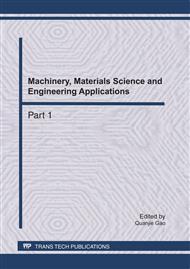p.259
p.265
p.270
p.276
p.283
p.288
p.293
p.299
p.303
Submicron Tungsten Powder Prepared through the Circulatory Oxidization-Reduction Method
Abstract:
Tungstic oxide is prepared with pure ammonium paratungstate in the air. And then Tungsten powder is obtained with tungstic oxide through deoxidation in the hydrogen gas (Rate of purity: 99.99 %, dew point: -40 °C), and tungsten powder is oxidized in the air. Tungstic oxide is reduced into tungsten powder in the hydrogen gas. The above routes are repeated. The samples are characterized by the laser particle size distribution measuring instrument and the electron probe scan instrument. The results show that submicron tungsten powder is obtained through circulatory oxidation twice and reductiuon three times. The volume percentage of the particle size distribution of submicron tungsten powder between 0.1 μm and 0.5 μm is 94.81 %.
Info:
Periodical:
Pages:
283-287
Citation:
Online since:
April 2011
Authors:
Price:
Сopyright:
© 2011 Trans Tech Publications Ltd. All Rights Reserved
Share:
Citation:


